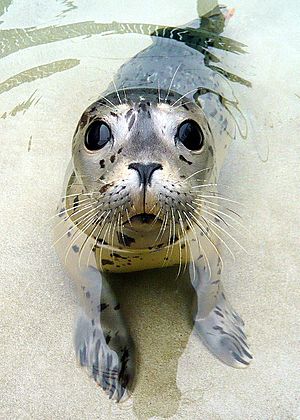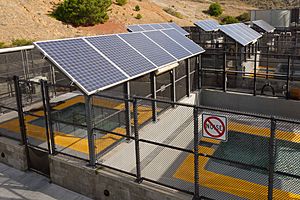The Marine Mammal Center facts for kids
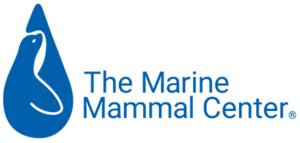 |
|
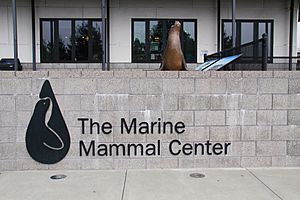
Headquarters front entrance
|
|
| Date opened | 1975 |
|---|---|
| Location | Sausalito, California, United States |
| Coordinates | 37°50′06″N 122°31′54″W / 37.8351°N 122.5316°W |
The Marine Mammal Center (TMMC) is a special place in the United States that helps marine mammals. It is a non-profit group that started in 1975. Their main goal is to rescue, heal, and then release marine mammals that are hurt, sick, or have been left alone.
TMMC was founded in Sausalito, California, by Lloyd Smalley, Pat Arrigoni, and Paul Maxwell. Since 1975, they have helped over 24,000 marine mammals. The center also does important research and teaches people about these amazing animals. They focus on cetaceans (like whales and dolphins), pinnipeds (like seals and sea lions), otters, and sirenians (like manatees). When they say an animal is "abandoned," it usually means a baby animal was separated from its mother too soon.
At the center, animals get special care from vets. They are checked, treated, and helped to get better. The goal is always to release them back into the wild. People usually find animals needing help and then call the center. The main types of animals they help are California sea lions, northern elephant seals, and Pacific harbor seals. Sometimes, they also help Steller sea lions, dolphins, and even sea turtles.
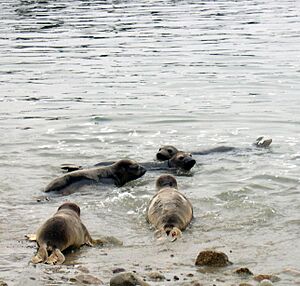
Contents
Discovering More About Marine Mammals
The research team at TMMC includes veterinarians and biologists. They not only diagnose and treat animals, but they also write scientific reports. These reports share information about marine animal health and how it relates to the Pacific Ocean's environment.
They work with other groups to learn about diseases, how animals' bodies fight sickness, and how the environment affects them. Sometimes, before an animal is released, it gets a special tag. This tag helps researchers track the animal and learn more about its life in the ocean. The center also works with experts from around the world on difficult cases.
Understanding Domoic Acid Poisoning
Researchers at TMMC found out that a natural toxin called domoic acid (DA) makes many California sea lions sick. DA is made by tiny ocean plants called Pseudo-nitzschia. Small sea creatures eat these plants, and then fish eat those creatures. The toxin builds up in the fish. Fish are not harmed by it, but mammals are.
California sea lions are often affected because they eat fish closer to shore, where more of these tiny plants live. When a marine mammal eats DA, it affects their brain. This can cause seizures. If they are exposed to it many times, it can cause lasting brain damage. Domoic acid is the same toxin that can make humans sick from eating contaminated shellfish.
Other Health Discoveries
TMMC, working with the University of Florida, also found that seal pox is a unique virus. It is different from chicken pox or smallpox. They are also studying why more marine mammals are getting leptospirosis. This is a type of bacteria that can harm their kidneys.
TMMC has also improved how they use anesthesia for marine mammals during surgery. It can be tricky because seals and sea lions can hold their breath for a long time. This makes giving them medicine to make them sleep more challenging.
If an animal dies or needs to be humanely put to sleep at the center, they perform a necropsy. This is like an animal autopsy. It helps them learn more for research. The public can sometimes watch this process. Animals are only put to sleep if their injuries or sickness are too severe to treat. This is done to prevent them from suffering.
Teaching About the Ocean
The center has a great education program that reaches over 100,000 students and adults every year. They teach people about how humans are connected to the ocean. Many groups of children visit the center. There was also a program called 'Sea to School' that visited schools in the Bay Area. The goal is that by understanding the ocean and its animals better, people will care for and protect them.
Helping Animals Get Better
The main goal for every animal TMMC rescues is to release it back into the ocean. Since 1975, they have rescued over 24,000 marine mammals. Most of these are California sea lions, northern elephant seals, and Pacific harbor seals. The center can care for up to 275 animals at one time.
In the spring, they often rescue young elephant seals and harbor seal pups. These babies might have been separated from their mothers by storms or human activity. Some might also be too young to find food on their own after being weaned. In the summer, they mostly rescue California sea lions that are about one year old and struggling to find food. They also help adult sea lions with diseases like domoic acid poisoning or leptospirosis.
About 80 to 100 animals each year need help because of human actions. This includes getting tangled in plastic or fishing gear, eating trash, being bothered on the beach, or even being shot. At the center, volunteers and vets work around the clock. They give medicine, feed the animals, teach young seals to catch fish, and perform medical procedures like X-rays and surgeries.
When Animals Cannot Be Released
Most of the time, animals can be treated and returned to the ocean. But in very rare cases (less than 1%), some animals cannot be released. This might happen if an animal has been released twice but keeps coming back. This means they might be too used to people and can't survive alone.
Some animals might have injuries, like blindness, that prevent them from living independently in the wild. Even if they are healthy, they might not be able to find food or protect themselves. In these situations, TMMC works with the National Oceanic and Atmospheric Administration (NOAA) to find a permanent home for the animal at an approved zoo or aquarium. For example, in May 2011, the San Francisco Zoo took in two blind California sea lions named Silent Knight and Henry.
The Center's Location and Operations
The main center is in the Marin Headlands. They also have smaller stations in San Luis Obispo, Monterey, Anchor Bay, and Fort Bragg. The center rescues animals along about 600 miles of the California Pacific Coast.
The Marine Mammal Center is located on what used to be a Nike Missile site. This was a military base from 1953 to 1979, built to protect against attacks. The site was closed in 1974, and TMMC opened there in 1975. The underground missile silos now hold the center's water filtration system. A small building that was once a guard house is now part of the Harbor Seal Hospital.
How the Center is Funded
The Marine Mammal Center gets all its money from private donations. In 2012, their yearly budget was about $7.5 million. Most of this money (81%) went directly to caring for animals, vet costs, and education programs. In 2012, 76% of their money came from private donations and memberships.
The center has about 45 paid staff members. But they rely on hundreds of volunteers. These volunteers are trained to help with rescues, animal care, and education.
The main facility in Sausalito can care for about 1,200 animals each year. A typical year sees between 600 and 800 patients. In 2009, a lack of fish due to weather patterns brought 1,750 patients to TMMC, which was the most ever. In 2012, they had the highest success rate for animals surviving and being released.
Growing and Improving
When TMMC started in 1975, they used bathtubs and small pools. In June 2009, they opened a new, larger facility. It was built using recycled materials. Solar panels provide about 20% of the center's energy. Water, which used to be very expensive, is now filtered and reused. They can recover 80% of their water.
During the rebuilding, they created many outdoor pens with pools. They also built special areas like a veterinary hospital, food preparation rooms, and storage for rescue gear. The hospital has an operating room and treatment areas. They can perform complex surgeries like thoracic (chest) and gastrointestinal (stomach) surgeries, as well as routine check-ups.
Amazing Rescue Stories
Here are some examples of the thousands of successful rescues TMMC has done:
Humpback Whale Rescue. In December 2005, a large female humpback whale got tangled in fishing lines near the Farallon Islands. She was migrating to Mexico. Center staff and volunteers, along with divers, bravely rescued her. This was the center's first successful open ocean whale rescue.
Orphaned Steller Sea Lion Pup. In 1999, a small, malnourished Steller sea lion pup named Artemis was found alone. She was healed and returned to the wild. Six years later, in July 2005, she was seen again, giving birth to her own pup! This was very special because no pups had been born on that island for at least twenty years.
Humphrey the Whale. Humphrey was a famous humpback whale who accidentally swam into San Francisco Bay twice. This happened in 1985 and 1990. Each time, the center, with help from the United States Coast Guard and many volunteers, helped guide him back to the ocean.
Baker D. the Dolphin. In November 2004, a bottlenose dolphin named Baker D. was successfully treated and released. He then joined a group of dolphins in Monterey Bay.
Sergeant Nevis the Sea Lion. On December 5, 2009, a large male California sea lion named Sgt. Nevis was rescued. He had been shot in the face. Imaging tests showed he had been shot several times before. After months of care, it was clear he couldn't survive in the ocean. He was moved to a permanent home at Six Flags Discovery Kingdom in Vallejo, California.
The U.S. Marine Mammal Protection Act of 1972 makes it illegal to harm marine mammals.
On October 8, 2010, Sgt. Nevis had major surgery to fix the wound on his face. This injury made it hard for him to breathe and dive. A special surgeon, Dr. Praful Ramenini, donated his time for this complex surgery.
On October 15, 2010, the person who shot Sgt. Nevis was found guilty. He was sentenced to jail time, probation, and had to pay over $51,000 to TMMC for Sgt. Nevis's care.
Movie Sounds. Did you know that the sounds of the Orcs and Uruks in Peter Jackson's Lord of the Rings movies came from TMMC? The sound designer recorded the vocalizations of northern elephant seals and California sea lions at the center!
See also
- Cetacean Conservation Center
- Endangered species
- Moss Landing Marine Laboratories
- Institute for Marine Mammal Studies
- Red tide


